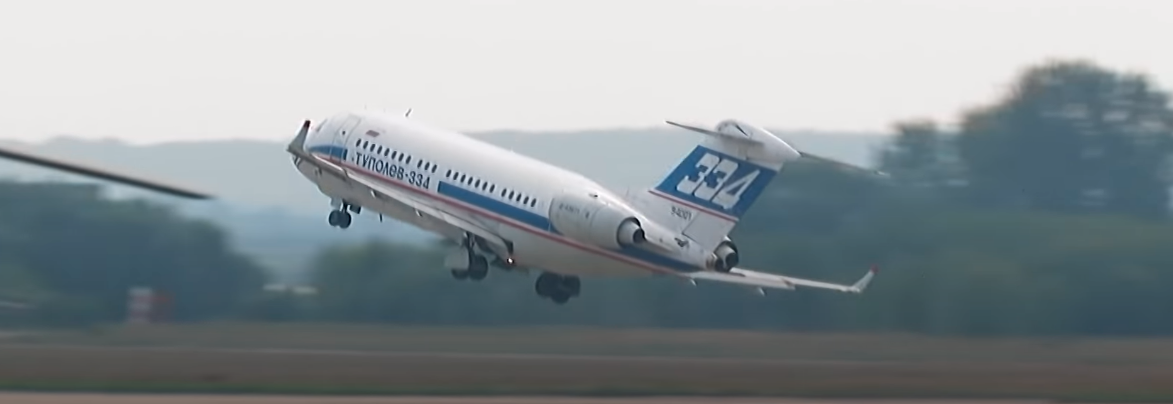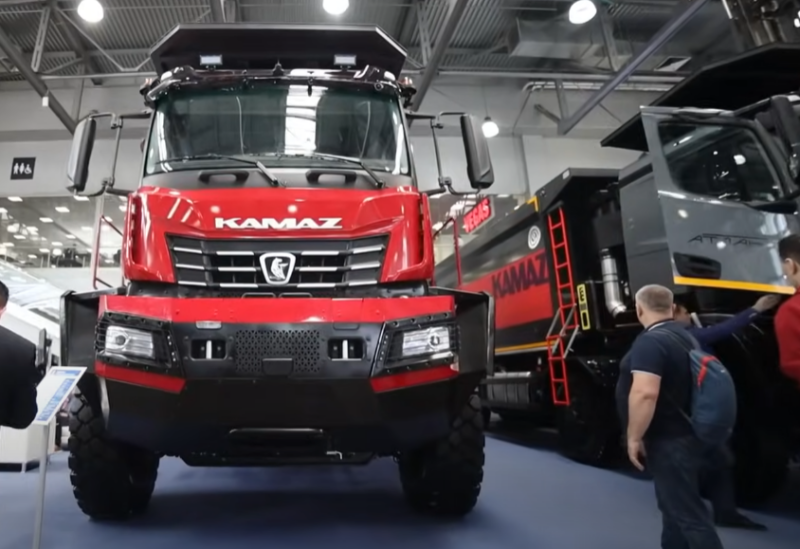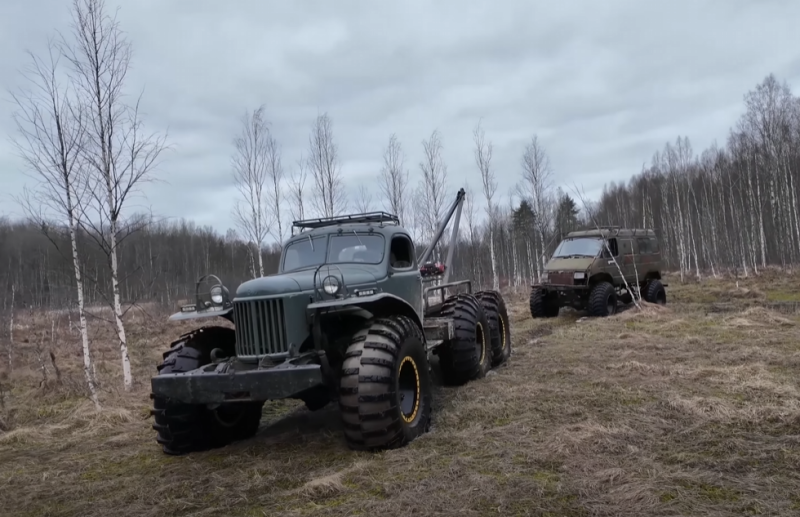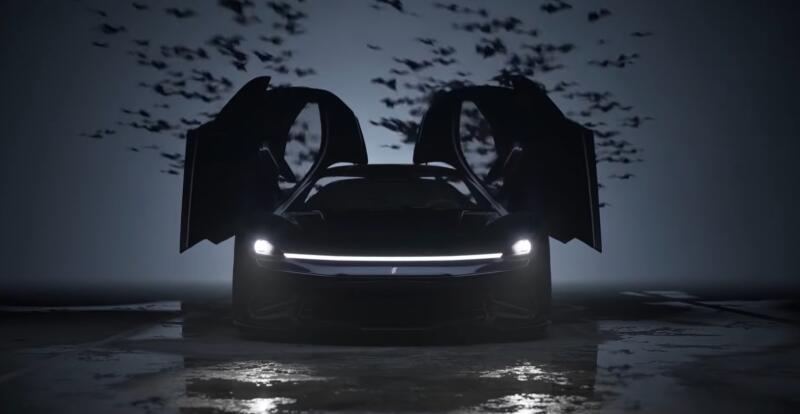Design
In the aerodynamic sense, it is a monoplane with a pair of engines in the rear and a T-tail. The wings have a very developed mechanization: ailerons, flaps, slats, spoilers, winglets (upward bends). All this "wealth" provided better lift during takeoff and braking on landing. The fuselage is made of light alloys and composites (partially wings and tail).
 This is how the wing equipment works. Photo: YouTube.com
This is how the wing equipment works. Photo: YouTube.comThe crew consisted of the commander, co-pilot and flight engineer. The cabin at that time (early 90s) was “advanced” - improved ergonomics plus a display instead of round instruments. The passenger compartment had a wide passage and could accommodate, depending on the "configuration" of the liner, a different number of people:
✅ tourist option - 126 seats with a step of 0,81 m
✅ economy class - 137 seats (the distance between them is 0,75 m)
✅ mixed type - 116 passengers (in the "business lounge" seat pitch is 1,02 m for 8 people)
On the plane it was possible to show videos, “twist” music: options unheard of at that time! The liner used the latest almost silent air conditioning system.
 Interior trim Tu-334 is made of non-combustible materials. Photo: YouTube.com
Interior trim Tu-334 is made of non-combustible materials. Photo: YouTube.comLarger closable luggage racks were also provided. In addition to them, two cargo compartments "relied" on a regular basis.
Test
For the first time, the aircraft standing on the ground was shown at the MAKS-95 aviation show. For the next three years, the concept was finalized and understaffed. The first takeoff of the liner took place in 1999 on February 8 (in total, a couple of Tu-334 copies were produced) under the leadership of A. N. Soldatenkov. After that, the aircraft was shown in “operational” form at the Dubai-2000 air show in Tehran. The main technical parameters of the short-haul airliner:
✅ wingspan - 29,77 m
✅ engine thrust - 7500 kgf
✅ weight of an empty aircraft (maximum takeoff) - 28,9 tons (47,9 tons)
✅ cruising speed - 820 km / h
✅ maximum height - 11,1 km
✅ range - up to 4100 km
An aircraft requires a 1,9 km runway for takeoff and 1 km for landing. Of the features, low engine noise was noted, which passengers almost did not hear. In addition to the main motors, an additional TA 18-100 installation was used, which was involved in the parking lots. The aircraft was equipped with an early warning system for emergencies and met international ICAO standards. In the future, it was planned to develop a training version of the liner for the training of military pilots.
Engines
It was with them, or rather because of them, as many experts believe, that the primary leapfrog happened with the plane. Initially, it was planned to install propfan motors D-80, created by Lotarev, on it (recall: the liner began to be developed in the 236s). According to the government assignment, the project should be ready by 1992. But economic difficulties began, and instead of the head of the design bureau Lanovsky, I. Kalygin was put in charge of development, in fact, at their last stage. The new chief designer is convinced that things are slowing down because of the engines, which are unclear when they will be ready. Based on the current situation, it was decided to adjust the almost finished project for the Zaporozhye D-436T1 engines.
 Russian aircraft with Ukrainian engines at the MAKS-2007 air show. Photo: YouTube.com
Russian aircraft with Ukrainian engines at the MAKS-2007 air show. Photo: YouTube.comAt the same time, it becomes clear: there is no time to remake the fuselage for more massive new engines. Attempts to lighten the liner were carried out: for example, they cut out part of the tail section. But still, the "overload" was 4 tons. Of these, 46% accounted for the structure itself, 14% for the power unit and the remaining 40% - the "fault" of the equipment.
When designing the Tu-334, most of the units were "removed" from the Tu-204, which at one time was unified with the Il-96. All this helped to gain weight.
Despite the development of the Tu-334-100 project with BR715 engines (Germany), which was supposed to "give a start in life" to the serial version of the liner (the latest project is the Tu-334SM), by the tenth years it became clear to everyone, including the Chief Designer, that the plane is obsolete.
Superjet rival
There is a version: the Tu-334 did not go into production due to the presence of its direct competitor, the Superjet-100. Whether this is true or not is still debated. However, there are facts: the Tu-334 did not participate in the competition for the best short-haul aircraft. Instead, the Tu-424 project was sent to the "bride" (the liner itself did not exist in reality). But there is another document - "Development of civil aviation" until 2010. Its creators recognized the Tu-334 as "competitive" in relation to the Superjet project, which turned out to be a priority.
 Competitor (or not) Tu-334 - Sukhoi Superjet 100. Photo: YouTube.com
Competitor (or not) Tu-334 - Sukhoi Superjet 100. Photo: YouTube.comAnother point that would be extremely important today: the Tu-334 was completely assembled from Russian components, except for engines manufactured in Ukraine (for comparison: the Sukhoi Superjet 100 has 80% of imported components and parts). Well, it is worth noting the high level of unification with the Tu-204 (according to some reports, it is 60%). However, the Tu-204, like its successor Tu-214, although by the piece, by order, is assembled in Kazan, unlike the Tu-334.
 The cockpit looks quite up to par: all the equipment is Russian. Photo: YouTube.com
The cockpit looks quite up to par: all the equipment is Russian. Photo: YouTube.comNevertheless, back in 2013, the then head of the Flight Research Institute, Pavel Nikolaevich Vlasov, identified the main disadvantages of the Tu-334: because of them, it can be considered an aircraft whose time has passed:
✅ crew of 3 people (today - no more than 2), although it was assumed that the commander and co-pilot would remain on the plane in the future
✅ obsolete avionics (see picture above);
✅ drawings made by hand
✅ lack of engines (the problem appeared after 2014)
The most interesting thing is that all of the above shortcomings are removable. The blueprints can be digitized, other avionics can be made, and the engines can be supplied from the Superjet. But in the latter case, you will have to redo the fuselage, and the French engine (by the way, not the best - airlines complain about a small raid before overhaul), "sanctioned". Solving problems takes time, finances) and considerable).
The head of the Ministry of Industry and Trade of the Russian Federation D. Manturov put an end to the fate of the Tu-334 project when answering questions from journalists. The official said the development was a "dead end" when compared to the Superjet. Today, the Russian Federation, if it launched the Tu-334 into a series, would be able to sell it to some countries. But then the country would not have received valuable "developments" in modern aircraft construction, which help to move forward in this matter.
 Tu-334 - will there still be a takeoff? Photo: YouTube.com
Tu-334 - will there still be a takeoff? Photo: YouTube.comThe minister added: the special value of the Superjet project lies in the creation of personnel capable of operating a new type of liner, as well as the amount of accumulated technologies and practical solutions. It was they who made it possible to rise to the next step - the creation of the MS-21 narrow-body airliner. And in the future - to develop, together with Chinese engineers, a project for an aircraft of the same type, but already a wide-body one.










